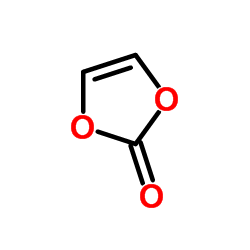1,3-Dioxol-2-one

1,3-Dioxol-2-one structure
|
Common Name | 1,3-Dioxol-2-one | ||
|---|---|---|---|---|
| CAS Number | 872-36-6 | Molecular Weight | 86.046 | |
| Density | 1.4±0.1 g/cm3 | Boiling Point | 79.2±23.0 °C at 760 mmHg | |
| Molecular Formula | C3H2O3 | Melting Point | 19-22 °C(lit.) | |
| MSDS | Chinese USA | Flash Point | 72.8±0.0 °C | |
| Symbol |




GHS05, GHS06, GHS08, GHS09 |
Signal Word | Danger | |
|
Pwp1 is required for the differentiation potential of mouse embryonic stem cells through regulating Stat3 signaling.
Stem Cells 33(3) , 661-73, (2015) Leukemia inhibitory factor/Stat3 signaling is critical for maintaining the self-renewal and differentiation potential of mouse embryonic stem cells (mESCs). However, the upstream effectors of this pathway have not been clearly defined. Here, we show that peri... |
|
|
The CB₁ cannabinoid receptor signals striatal neuroprotection via a PI3K/Akt/mTORC1/BDNF pathway.
Cell Death Differ. 22 , 1618-29, (2015) The CB1 cannabinoid receptor, the main molecular target of endocannabinoids and cannabis active components, is the most abundant G protein-coupled receptor in the mammalian brain. In particular, the CB1 receptor is highly expressed in the basal ganglia, mostl... |
|
|
Analysis of IL-6/gp130 family receptor expression reveals that in contrast to astroglia, microglia lack the oncostatin M receptor and functional responses to oncostatin M.
Glia 63(1) , 132-41, (2014) The interleukin (IL)-6/gp130 family of cytokines (e.g., IL-6, IL-11, leukemia inhibitory factor (LIF) and oncostatin M (OSM)) play important roles in the central nervous system (CNS) during neuroinflammation and neurodevelopment. However, little is known rega... |
|
|
Characterization and hepatoprotective effect of polysaccharides from Ziziphus jujuba Mill. var. spinosa (Bunge) Hu ex H. F. Chou sarcocarp.
Food Chem. Toxicol. 74 , 76-84, (2014) The polysaccharides from Ziziphus jujuba Mill. var. spinosa (Bunge) Hu ex H. F. Chou sarcocarp (PWJS) is evaluated for the chemical composition, antioxidant activity and hepatoprotective effect. The characteristics of PWJS were determined by FT-IR spectral an... |
|
|
New Protocol to Optimize iPS Cells for Genome Analysis of Fibrodysplasia Ossificans Progressiva.
Stem Cells 33 , 1730-42, (2015) Successful in vitro disease-recapitulation using patient-specific induced pluripotent stem cells (iPSCs) requires two fundamental technical issues: appropriate control cells and robust differentiation protocols. To investigate fibrodysplasia ossificans progre... |
|
|
Human myocardial pericytes: multipotent mesodermal precursors exhibiting cardiac specificity.
Stem Cells 33(2) , 557-73, (2015) Perivascular mesenchymal precursor cells (i.e., pericytes) reside in skeletal muscle where they contribute to myofiber regeneration; however, the existence of similar microvessel-associated regenerative precursor cells in cardiac muscle has not yet been docum... |
|
|
Lipid mediator profile in vernix caseosa reflects skin barrier development.
Sci. Rep. 5 , 15740, (2015) Vernix caseosa (VC) is a protective layer that covers the skin of most human newborns. This study characterized the VC lipid mediator profile, and examined its relationship to gestational period, gender of the newborn and maternal lifestyle. VC collected at b... |
|
|
Phosphate binders prevent phosphate-induced cellular senescence of vascular smooth muscle cells and vascular calcification in a modified, adenine-based uremic rat model.
Calcif. Tissue Int. 96(4) , 347-58, (2015) Clinical and experimental studies have reported that phosphate overload plays a central role in the pathogenesis of vascular calcification in chronic kidney disease. However, it remains undetermined whether phosphate induces cellular senescence during vascula... |
|
|
Specific overexpression of tumour necrosis factor-α-induced protein (TNFAIP)9 in CD14(+) CD16(-) monocytes in patients with rheumatoid arthritis: comparative analysis with TNFAIP3.
Clin. Exp. Immunol. 180 , 458-66, (2015) The tumour necrosis factor (TNF)-α-induced proteins (TNFAIP)9 and TNFAIP3 play an important pathogenic role in murine arthritis. To clarify their pathophysiological roles in patients with rheumatoid arthritis (RA), we examined their expression and localizatio... |
|
|
Preparation and in vitro antioxidant activities of 6-amino-6-deoxychitosan and its sulfonated derivatives.
Biopolymers 103 , 539-49, (2015) The 6-amino-6-deoxychitosan (NC) and their 2, 6-di-N-sulfonated derivatives were prepared via N-phthaloylation, tosylation, azidation, hydrazinolysis, reduction of azide groups and N-sulfonation, and their structures were systematically characterized by FT-IR... |